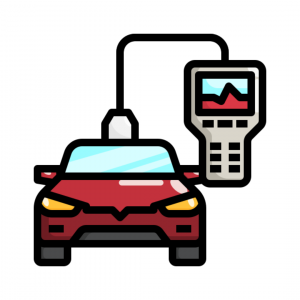In the world of modern vehicle diagnostics, understanding fault codes plays a crucial role in effectively identifying and resolving issues. Fault codes are numerical or alphanumeric combinations that provide valuable information about specific problems occurring within a vehicle’s systems. They serve as a language through which the vehicle’s onboard computer communicates with mechanics and technicians, offering insights into the root causes of malfunctions.
When a vehicle’s onboard computer system detects an issue, it generates a fault code that corresponds to the specific problem. These fault codes can range from simple to complex, covering various systems and components such as the engine, transmission, brakes, and more. To decipher these fault codes and gain a clear understanding of the underlying issues, mechanics, and technicians rely on OBD (On-Board Diagnostics) scanners.
OBD scanners are powerful tools designed to interface with a vehicle’s onboard computer system and retrieve fault codes. By connecting the scanner to the vehicle’s OBD port, which is typically located under the dashboard, mechanics can access a wealth of diagnostic information. OBD scanners read the fault codes stored in the vehicle’s computer and provide detailed descriptions of the problems detected.
The role of OBD scanners in reading and diagnosing fault codes is instrumental in efficient vehicle maintenance and repair. These scanners enable mechanics and technicians to:
- Retrieve fault codes: OBD scanners can retrieve fault codes stored in the vehicle’s computer, providing valuable information about the specific issues affecting different systems and components.
- Interpret fault codes: OBD scanners translate fault codes into understandable descriptions, helping mechanics identify the root causes of malfunctions and determine the necessary repairs or adjustments.
- Perform live data monitoring: OBD scanners can display real-time data from various sensors and components, allowing mechanics to analyze the performance of different systems and make informed diagnostic decisions.
- Clear fault codes: OBD scanners provide the capability to clear fault codes after repairs have been made, allowing mechanics to verify the effectiveness of their interventions and ensure that the issues have been resolved.
By utilizing OBD scanners to read and diagnose fault codes, mechanics and technicians can streamline the troubleshooting process, saving time and effort while ensuring accurate problem identification. This ultimately leads to more efficient repairs, improved vehicle performance, and enhanced customer satisfaction.
In the following sections of this article, we will delve deeper into the world of fault codes and explore how OBD scanners play a vital role in the diagnostic process. We will discuss the types of fault codes, their meanings, and common diagnostic techniques employed by mechanics. So, let’s embark on this journey of understanding fault codes and the invaluable role of OBD scanners in vehicle diagnostics.
Recommended – Top 5 Most Common Signs of Bad Suspension
Table of Contents
What are Fault Codes?

Fault codes are numerical or alphanumeric combinations that serve as diagnostic indicators of specific issues within a vehicle’s systems. They provide valuable information about malfunctions, abnormalities, or failures detected by the vehicle’s onboard computer system. These codes act as a communication tool between the vehicle and mechanics or technicians, aiding in the troubleshooting and repair process.
When a vehicle’s onboard computer system detects a problem, it generates a fault code based on predefined parameters and diagnostic algorithms. The system continuously monitors various sensors, components, and subsystems, comparing their performance to predetermined thresholds. If any parameter falls outside the expected range, the onboard computer system identifies the issue and generates a corresponding fault code.
The generation of fault codes involves several steps:
- Sensor Data Analysis: The onboard computer system continuously receives data from various sensors throughout the vehicle, such as oxygen sensors, throttle position sensors, temperature sensors, and more. These sensors provide information about the vehicle’s performance and operating conditions.
- Parameter Comparison: The onboard computer system compares the data received from the sensors with predefined values or thresholds stored in its memory. These values are based on manufacturer specifications and standards.
- Fault Detection: If the data from the sensors deviates from the expected values, indicating a potential problem or malfunction, the onboard computer system recognizes the issue and assigns a specific fault code.
- Fault Code Generation: Once the fault is detected, the onboard computer system generates a fault code, which consists of a unique combination of numbers or alphanumeric characters. Each fault code corresponds to a specific issue or system within the vehicle.
Fault codes can cover various vehicle systems and components, including the engine, transmission, brakes, fuel system, emissions system, and more. They provide mechanics and technicians with a starting point for diagnosis by indicating the area or system where the problem is likely to be located.
In the next section, we will explore how mechanics and technicians can effectively interpret fault codes using OBD scanners to identify and diagnose vehicle problems accurately. Understanding fault codes is essential for efficient and accurate troubleshooting, ensuring that the right repairs or adjustments are made to resolve the issues. So, let’s delve deeper into the world of fault codes and their significance in the diagnostic process.
Recommended – A Comprehensive Guide to Choosing the Right OBD Scanner for Your Vehicle
Types of Fault Codes

When it comes to fault codes, there are two main types: generic fault codes and manufacturer-specific fault codes. Understanding the differences between these types is crucial for effective diagnosis using OBD scanners.
A. Overview of Generic and Manufacturer-Specific Fault Codes
- Generic Fault Codes: Generic fault codes, also known as Powertrain or P-codes, are standardized codes that are common across different vehicle makes and models. These codes follow a universal set of definitions outlined by the Society of Automotive Engineers (SAE). For instance, the P0300 code typically represents a random misfire detected in one or more cylinders, regardless of the vehicle’s brand. Generic fault codes provide a general starting point for diagnosis but may not offer detailed information about specific vehicle systems or components.
- Manufacturer-Specific Fault Codes: Manufacturer-specific fault codes, also referred to as Enhanced or P1 codes, are specific to particular vehicle manufacturers. These codes provide more detailed and precise information about the issues detected by the vehicle’s onboard computer system. Since manufacturers have their own set of diagnostic protocols and specific systems, these codes can offer insights into the unique characteristics of a particular vehicle’s components and subsystems. For example, a P0171 code in a Chevrolet vehicle may indicate a system lean condition in the fuel injection system, providing more specific diagnostic guidance for that particular make and model.
Recommended – OBD Scanners and Emissions Testing: A Comprehensive Guide
B. Understanding the Alphanumeric Structure of Fault Codes
Fault codes are typically composed of alphanumeric characters. Each character or group of characters carries specific information about the type of fault, system, or component involved. Here’s a breakdown of the typical structure of fault codes:
- First Character: The first character of the fault code identifies the general area or system affected by the issue. For example, a “P” denotes a powertrain-related issue, while a “B” refers to the body system.
- Second Character: The second character provides more specific information about the subsystem within the general area. For instance, a “0” indicates a generic fault code, while a “1” indicates a manufacturer-specific fault code.
- Remaining Characters: The remaining characters in the fault code sequence further specify the particular issue or component involved. These characters may represent numbers, letters, or a combination of both.
By understanding the structure of fault codes, mechanics and technicians can decipher the underlying meaning and quickly identify the relevant system or component related to the detected fault.
In the next section, we will explore how OBD scanners can retrieve and interpret these fault codes, empowering users to diagnose and address vehicle problems accurately. OBD scanners play a crucial role in fault code retrieval and interpretation, making them indispensable tools for efficient vehicle diagnostics and repairs. Let’s dive into the details of how OBD scanners help in diagnosing and resolving issues based on the fault codes they provide.
Recommended – OES vs OEM: Understanding the Difference and Making Informed Choices
Interpreting Fault Codes
Once you have retrieved the fault codes from your vehicle using an OBD scanner, the next step is to interpret them accurately. Understanding the information conveyed by the fault codes is vital in diagnosing the specific issues or components that require attention. Here’s how you can interpret fault codes with the help of OBD scanners:
A. Using OBD Scanners to Retrieve Fault Codes
OBD scanners are designed to communicate with your vehicle’s onboard computer system and retrieve fault codes stored in its memory. By connecting the OBD scanner to the OBD-II port of your vehicle, you can initiate a code retrieval process. The scanner will then communicate with the vehicle’s computer and retrieve the relevant fault codes associated with any detected issues.
B. Decoding Fault Codes to Identify Specific Issues or Components
Once you have the fault codes in hand, it’s time to decode them and understand their meaning. Fault codes consist of a series of alphanumeric characters that provide specific information about the detected issue. Each character or group of characters represents a particular aspect related to the fault. By referring to code definitions or diagnostic resources, you can decipher the fault codes and identify the specific issues or components involved. For example, a fault code like P0420 might indicate a problem with the catalytic converter.
C. Accessing Code Descriptions and Meanings through Code Libraries or Online Resources
To ensure an accurate interpretation of fault codes, it is essential to access code descriptions and meanings. Code libraries or online resources dedicated to OBD codes provide comprehensive databases that contain detailed information about various fault codes. These resources often include code definitions, possible causes, and suggested diagnostic and repair procedures. By referring to these code libraries or online resources, you can gain valuable insights into the specific issues indicated by the fault codes retrieved from your vehicle.
By effectively interpreting fault codes, you can narrow down the potential problems within your vehicle and focus your diagnostic efforts on the specific components or systems related to the detected issues. In the next section, we will explore the steps involved in diagnosing and resolving vehicle problems based on the fault codes retrieved through OBD scanners.
Recommended – The Beginner’s Guide to OBD: How OBD Works?
Common Fault Codes and Their Meanings

When it comes to diagnosing vehicle issues using OBD scanners, understanding common fault codes and their meanings is crucial. Here are some examples of common fault codes and their implications, along with insights into the potential causes behind them:
A. Exploring Examples of Common Fault Codes and Their Implications
- P0300 – Random/Multiple Cylinder Misfire Detected: This fault code indicates that the engine is experiencing misfires in multiple cylinders, which can lead to poor performance, rough idling, or even engine damage.
- P0171 – System Too Lean (Bank 1): This code suggests that there is a fuel delivery issue, resulting in a lean air-fuel mixture in the engine’s bank 1. It may be caused by a vacuum leak, a faulty oxygen sensor, or a clogged fuel injector.
- P0420 – Catalyst System Efficiency Below Threshold (Bank 1): This fault code indicates that the catalytic converter’s performance is below the expected threshold. It could be due to a faulty converter, oxygen sensor, or an exhaust leak.
B. Understanding the Potential Causes Behind Specific Fault Codes
- Misfires: Misfires can be caused by various factors, including spark plug or ignition coil issues, fuel delivery problems, or engine timing abnormalities. Thorough inspection and testing are necessary to pinpoint the exact cause.
- Lean Air-Fuel Mixture: A lean condition can be the result of a vacuum leak, faulty mass airflow sensor, or restricted fuel supply. Careful examination of intake components and fuel delivery systems is essential to identify the root cause.
- Catalytic Converter Efficiency: A poorly performing catalytic converter can be caused by a faulty converter itself or underlying issues such as oxygen sensor malfunction or exhaust system leaks. Proper diagnosis is crucial to determine the exact source of the problem.
By understanding these common fault codes and their implications, you can gain insights into the potential issues affecting your vehicle’s performance. However, it’s important to note that fault codes provide a starting point for diagnosis and further investigation is often required to identify the root cause accurately. In the next section, we will discuss the steps involved in diagnosing and resolving vehicle problems based on the fault codes retrieved through OBD scanners, empowering you to effectively diagnose and address issues using the power of OBD scanners.
Recommended – Top 5 Symptoms of a Bad Exhaust System You Should Lookout For
Diagnosing Fault Codes with OBD Scanners

When you encounter a fault code on your vehicle’s OBD scanner, it’s essential to perform additional diagnostic tests to pinpoint the underlying issue accurately. Here are some steps you can take to diagnose with OBD scanners:
A. Performing Additional Diagnostic Tests Based on Fault Codes
- Visual Inspection: Start by visually inspecting the relevant components and wiring associated with the fault code. Look for loose connections, damaged wires, or signs of wear that may be contributing to the issue.
- Functional Tests: Depending on the fault code, perform functional tests on related systems or components. For example, if the code indicates an issue with the oxygen sensor, you can conduct a sensor test or check its voltage output using the OBD scanner.
B. Utilizing Live Data Streaming and Sensor Readings for Further Analysis
- Live Data Streaming: Take advantage of the live data streaming feature on your OBD scanner. Monitor sensor readings in real-time to observe their behavior during various driving conditions. This can provide valuable insights into potential issues and help identify patterns or abnormalities.
- Sensor Readings and Freeze Frame Data: Review the sensor readings and freeze frame data associated with the fault code. Sensor readings can provide specific information about the condition of various engine components, while freeze frame data captures the snapshot of vehicle parameters at the time the fault code was triggered.
C. Troubleshooting Steps to Identify and Resolve the Root Cause of the Fault Code
- Consult Repair Manuals and Online Resources: Use repair manuals specific to your vehicle or reliable online resources to gain insights into common causes associated with the fault code. These resources often provide troubleshooting flowcharts or step-by-step instructions for further diagnosis.
- Conduct Component Testing: Depending on the fault code and associated symptoms, conduct specific component tests to assess their functionality. This may include testing sensors, valves, or other electrical or mechanical components using appropriate tools and techniques.
- Address the Root Cause: Once you have identified the root cause of the fault code, take appropriate steps to address it. This may involve component replacement, repair, or adjustment, depending on the nature of the issue.
By following these diagnostic steps, you can effectively utilize OBD scanners to diagnose and address vehicle problems based on the retrieved fault codes. Remember that diagnosing and resolving issues requires a systematic approach, and in some cases, professional assistance may be necessary. In the next section, we will discuss preventive measures and best practices to keep your vehicle in optimal condition, reducing the likelihood of encountering fault codes in the future.
Recommended – Car Modification in India | legal vs illegal – Everything You Need to Know
Clearing Fault Codes

Once you have diagnosed with the OBD scanner and addressed the underlying issues indicated by the fault codes, it is crucial to clear the fault codes from the vehicle’s system. Clearing the fault codes serves several important purposes and can be easily done with the help of OBD scanners.
A. Importance of Clearing Fault Codes After Diagnosis and Repairs
- System Integrity: Clearing fault codes ensures that the vehicle’s system is free from any stored codes related to previously diagnosed or resolved issues. It helps maintain the integrity of the system and ensures accurate future fault code readings.
- Monitoring Progress: Clearing fault codes allows you to monitor the progress of your repairs or maintenance actions. By clearing the codes and performing subsequent tests or driving cycles, you can confirm that the repairs were successful and that the fault codes do not reappear.
B. Using OBD Scanners to Clear Fault Codes and Reset the Vehicle’s System
- Accessing Clearing Functions: OBD scanners provide the capability to clear fault codes and reset the vehicle’s system. The specific steps may vary depending on the scanner model, but typically involve navigating through the scanner’s menu or selecting the appropriate function.
- Performing the Clearing Process: Once you have accessed the clearing function on the OBD scanner, follow the on-screen prompts or instructions to initiate the clearing process. The scanner communicates with the vehicle’s onboard computer system to erase the stored fault codes.
- Verifying Successful Clearing: After clearing the fault codes, it is advisable to re-scan the system to ensure that the codes have been successfully cleared. This verification step provides assurance that the fault codes are no longer present and that the system is in a clean state.
Remember to follow the manufacturer’s instructions and guidelines provided with your OBD scanner when clearing fault codes. It is also essential to note that clearing fault codes does not address any underlying issues that may still exist in the vehicle. If the issues persist or new fault codes appear, further diagnosis and repairs may be necessary.
In the next section, we will discuss preventive measures and maintenance practices to help minimize the occurrence of fault codes and keep your vehicle running smoothly.
Recommended – Top 11 Essential Tools to Keep in Your Car
Tips for Effective Fault Code Diagnosis

A. Regularly Updating OBD Scanner Software for Improved Code Definitions
To ensure accurate and up-to-date code definitions, it is important to regularly update the software of your OBD scanner. Manufacturers often release software updates that provide enhanced code definitions and additional diagnostic capabilities. By keeping your scanner software updated, you can improve the accuracy and reliability of your fault code diagnosis.
B. Understanding the Context of Fault Codes and Considering Related Components
When diagnosing fault codes, it is crucial to understand the context in which they occur. Fault codes are often related to specific components or systems within the vehicle. However, it is essential to consider the interconnected nature of these components and systems. A fault code may indicate a problem with one component, but it could be caused by a related component or system. Therefore, it is important to conduct a comprehensive diagnosis that includes checking related components and systems to identify the root cause of the fault code.
C. Seeking Professional Assistance for Complex or Persistent Fault Codes
While OBD scanners provide valuable diagnostic capabilities, some fault codes can be complex and require specialized knowledge or equipment to diagnose accurately. If you encounter persistent or challenging fault codes that you are unable to diagnose or resolve on your own, it is recommended to seek professional assistance. Automotive technicians and professionals have extensive experience and access to advanced diagnostic tools, enabling them to effectively diagnose and repair complex issues.
Remember, effective fault code diagnosis requires a combination of technical knowledge, experience, and the right tools. By following these tips, you can enhance your ability to diagnose and address fault codes using your OBD scanner.
In the next section, we will discuss preventive measures and maintenance practices to help minimize the occurrence of fault codes and keep your vehicle running smoothly.
Recommended – How to Make Car AC Colder | Extensive Guide
Conclusion
A. Recap of the Significance of Understanding and Diagnosing Fault Codes
Understanding and diagnosing fault codes is crucial for effective vehicle maintenance and troubleshooting. Fault codes provide valuable insights into the health and performance of various vehicle components and systems. By deciphering these codes, you can identify underlying issues and take timely corrective actions, preventing potential breakdowns and costly repairs. OBD scanners play a vital role in reading and interpreting fault codes, empowering you to diagnose problems accurately and efficiently.
B. Encouragement to Utilize OBD Scanners for Effective Troubleshooting and Maintenance
As modern vehicles become more complex, utilizing OBD scanners for fault code diagnosis is increasingly important. These scanners provide access to valuable diagnostic information, enabling you to pinpoint specific issues and address them promptly. By using OBD scanners regularly, you can stay proactive in maintaining your vehicle’s health, prolong its lifespan, and ensure optimal performance. Whether you are a DIY enthusiast or a professional technician, incorporating OBD scanners into your diagnostic toolkit is a wise decision.
In conclusion, understanding and diagnosing fault codes with the help of OBD scanners empower you to take control of your vehicle’s maintenance and repair process. By deciphering fault codes, performing additional diagnostic tests, and utilizing live data streaming, you can troubleshoot issues effectively and make informed decisions regarding necessary repairs or component replacements. Embrace the power of OBD scanners in diagnosing and addressing fault codes, and enjoy the benefits of a well-maintained and reliable vehicle.
Remember, regular maintenance, prompt diagnosis, and appropriate repairs are the keys to keeping your vehicle in optimal condition. Stay informed, leverage the capabilities of OBD scanners, and enjoy a smoother and more enjoyable driving experience.

